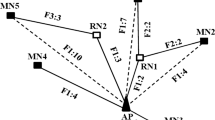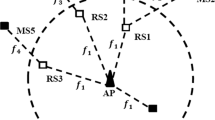Abstract
Future mobile handsets will often be multi-mode, containing both wireless LAN (WLAN) and cellular air interfaces. When such a device is within a WLAN it can be served by the WLAN resources. As it moves out of the WLAN coverage area, it has to be served by the cellular system. Therefore, handoffs are necessary between the WLAN and the cellular system. In loosely coupled WLAN/Cellular systems the system administrator of the WLAN is different from the cellular one. Therefore, in these situations, reducing the dropping probability based on classical methods, such as using some reserved guard channels, is difficult. In this paper, we propose to use ad hoc relaying during the vertical handoff process in a hybrid WLAN/Cellular system. The method that we propose in this paper improves the dropping probability regardless of the number of reserved channels. Therefore, this method could be employed in loosely coupled hybrid systems. Both analytical reasoning and simulation results support the effectiveness of the proposed method.
Similar content being viewed by others
References
IEEE Standards Department, IEEE Draft Standard - Wireless LAN, IEEE Press, 1996.
A. Doufexi, et al., “Hotspot Wireless LANs to Enhance the Performance of 3G and Beyond Cellular Networks”, IEEE Communications Mag., pp. 58–65, July 2003.
K. Ahmavaara, H. Haverinen, and R. Pichna, “Interworking Architecture Between 3GPP and WLAN Systems”, IEEE Communications Magazine, pp. 74–81, Nov. 2003.
Q. Zhang, et al., “Efficient Mobility Management for Vertical Handoff Between WWAN and WLAN”, IEEE Comm. Mag., pp. 102–108, Nov. 2003.
R. Fantacci, “Performance Evaluation of Prioritized Handoff Schemes in Mobile Cellular Networks”, IEEE Trans. On Vehicular Technology, Vol. 49, No. 2, pp. 485–493, 2000.
J. Misic and T.Y. Bun, “About the Problem of Hot-Spots Under Adaptive Admission Control in Wireless Multimedia Networks”, Proceedings of IEEE WCNC, pp. 1238–1242, 1999.
S. De, O. Tonguz, H. Wu, and C. Qiao, “Integrated Cellular and Ad Hoc Relay (iCAR) Systems: Pushing the Performance Limits of Conventional Wireless Networks”, Proceedings of HICSS, pp. 3899–3906, 2002.
T. Todd and D. Zhao, “Cellular CDMA Capacity in Hotspots with Limited Ad hoc Relaying”, Proceedings of IEEE PIMRC, 2003.
J.H. Yap. X. Yang et al., “Position Assisted Relaying and Handover in Hybrid Ad hoc WCDMA Cellular Systems”, Proceedings of IEEE PIMRC, pp. 2194–2198, Sept. 2002.
G.N. Aggelou and R. Tafazolli, “On the Relaying Capability of Next-Generation GSM Cellular Networks”, Proceedings of IEEE Personal Communications, pp. 40–47, Feb. 2001.
T. Rouse, S. McLaughlin, and H. Haas, “Coverage-Capacity Analysis of Opportunity Driven Multiple Access (ODMA) in UTRA TDD”, Proceedings of the International Conf. on 3G Mobile Communication Technologies, pp. 252–256, 2001.
M. He, T.D. Todd, D. Zhao, and V. Kezys, “Ad Hoc Assisted Handoff for Real-Time IEEE 802.11 Infrastructure WLANs”, Proceedings of the IEEE WCNC, 2004.
M. Rahnema, “Overview of the GSM System and Protocol Architecture”, IEEE Communications Magazine, April 1993.
J. Cai and D.J. Goodman, “General Packet Radio Service in GSM”, IEEE Communications Magazine, pp. 122–131, Oct. 1997.
J. Korhonen, Introduction to 3G Mobile Communications, Artech House, 2nd Edition, 2003.
D.B. Johnson and D.A. Maltz, “Dynamic Source Routing in Ad Hoc Wireless Networks”, In Tomasz Imielinski and Hank Korth Mobile Computing, eds., Kluwer Academic Publishers, Chap 5, p. 153–181, 1996.
C.E. Perkins and E.M. Royer, “Ad hoc On-Demand Distance Vector Routing”, Proceedings of the 2nd IEEE Workshop on Mobile Computing Systems and Applications, New Orleans, LA, pp. 90–100, February 1999.
R. Ramanathan and J. Redi, “A Brief Overview of Ad Hoc Networks: Challenges and Directions”, IEEE Communications Magazine, pp. 20–22, May 2002.
Y.D. Lin and Y.C. Hsu, “Multihop Cellular: A New Architecture for Wireless Communications”, Proceedings of Infocomm, pp. 1273–1282, 2000.
H.C. Chao and C.Y. Huang, “Micro-Mobility Mechanism for Smooth Handoffs in an Integrated Ad-Hoc and Cellular IPv6 Network Under High-Speed Movement”, IEEE Trans. on Vehicular Technology, Vol. 52, No. 6, pp.l576–1593, 2003.
D. Zhao, and T.D. Todd, “Real-Time Traffic Support in Relayed Wireless Access Networks Using IEEE 802.11”, IEEE Wireless Communications, pp. 32–39, April 2004.
V. Sreng, H. Yanikomeroglu, and D.D. Falconer, “Relayer Selection Strategies in Cellular Networks with Peer—to-Peer Relaying”, Proceedings of the IEEE VTC'F03, Oct. 2003.
J.W. Florolu, et al., “Seamless Handover in Trestrial Radio Access Networks: A Case Study”, IEEE Comm. Mag., pp. 110–116, Nov. 2003.
K. Pahlavan and P. Krishnamurthy, et al., “Handoff in Hybrid Mobile Data Networks”, IEEE Personal Communications, pp. 34–47, April 2000.
M. Portoles, et al., “IEEE 802.11 Link-Layer Forwarding for Smooth Handoff”, Proceedings of IEEE PIMRC, pp. 1420–1424, 2003.
Y. Pan, et al., “An End-to-End Multipath Smooth Handoff Scheme foe Stream Media”, IEEE JSAC, May 2004.
D. Tandjaoui, et al., “Performance Enhancement of Smooth Handoff in Mobile IP by Reducing Packets Disorder”, Proceedings of IEEE ISCC, 2003.
P. Khadivi, T.D. Todd, and D. Zhao, “Handoff Trigger Nodes for Hybrid IEEE 802.11 WLAN/Cellular Networks”, Proceedings of the First International Conference on Quality of Service in Heterogeneous Wired/Wireless Networks (Qshine 2004), Dallas, USA, pp. 164–170, 2004.
P. Khadivi, T.D.Todd, S. Samavi, H. Saidi, and D. Zhao, “Mobile Ad Hoc Relaying in Hybrid WLAN/Cellular Systems for Dropping Probability Reduction”, Proceedings of the 9th CDMA International Conference (CiC 2004), Korea, 25–28, Oct. 2004.
D. Hong and S.S. Rappaport, “Traffic Model and Performance Analysis for Cellular Mobile Radio Telephone Systems with Prioritized and Nonprioritized Handoff Procedures”, IEEE Trans. on Vehicular Technology, Vol. 35, No. 3, pp.. 448–461, Aug. 1986.
C. Bettstetter and C. Wagner, “The Spatial Node Distribution of the Random Waypoint Mobility Model”, Proceedings of WMAN, pp. 41–58, 2002.
P. Khadivi, S. Samavi, T.D. Todd, and H. Saidi, “Multi-Constraint QoS Routing Using a New Single Mixed Metric”, Proceedings of IEEE International Conference on Communications (ICC 2004), Vol. 4, 20–24 June Paris, France, pp. 2042–2046, 2004.
Author information
Authors and Affiliations
Corresponding author
Additional information
Pejman Khadivi received the BS and MS degrees in computer engineering (Hardware and Computer Systems Architecture) in 1998 and 2000, respectively from Isfahan University of Technology, where he is currently working toward his Ph.D. During the 2003/2004 academic year, he was a Visiting Researcher with the Electrical and Computer Engineering Department, McMaster University, ON, Canada. Different aspects of computer architecture and networking are Mr. Khadivi’s research interests specially, adhoc networks, QoS routing and seamless handoff in hybrid mobile networks.
Shadrokh Samavi received the B.S. degrees in industrial technology and electrical engineering from the California State University, Fresno, in 1980 and 1982, respectively, the M.S. degree from the University of Memphis, Memphis, TN, in 1985, and the Ph.D. degree in electrical engineering from Mississippi State University, Mississippi State, in 1989. In 1995, he joined the Electrical and Computer Engineering Department, Isfahan University of Technology, Isfahan, Iran, where he was an Associative Professor. During the 2002/2003 academic year, he was a Visiting Professor with the Electrical and Computer Engineering Department, McMaster University, Hamilton, ON, Canada. His current research interests are implementation and optimization of image-processing algorithms and area-performance tradeoffs in computational circuits. Dr. Samavi is a Registered Professional Engineer (P.E.), USA, and is a member of Eta Kappa Nu, Tau Beta Pi, and the National Association of Industrial Technologists (NAIT).
Hossein Saidi received the B.S. and M.S. degrees in electrical engineering (Electronics and communication Eng.) from Isfahan University of Technology (IUT), in 1986 and 1989, respectively, and the Ph.D. degree in electrical engineering from the Washington University in St. Louis, MO. in 1994.
From 1994 to 1995, he was a research associates at Washington Univ. St. Louis, and in 1995 he joined the Electrical and Computer Engineering of IUT, where he is an Associate Professor. His Research interest includes ATM, high speed networking, QoS guarantees, routing, algorithms and information theory.
Terence D. Todd received the B.A.Sc, M.A.Sc and Ph.D degrees in Electrical Engineering from the University of Waterloo, Waterloo, Ontario, Canada. While at Waterloo he spent 3 years as a Research Associate with the Computer Communications Networks Group (CCNG). He is currently a Professor of Electrical and Computer Engineering at McMaster University in Hamilton, Ontario, Canada.
Professor Todd spent 1991 on research leave in the Distributed Systems Research Department at AT&T Bell Laboratories in Murray Hill, NJ. He also spent 1998 on research leave at The Olivetti and Oracle Research Laboratory in Cambridge, England. While at ORL he worked on the piconet project which was an early embedded wireless network testbed.
Dr. Todd’s research interests include metropolitan/local area networks, wireless communications and the performance analysis of computer communication networks and systems. He currently holds the NSERC/RIM/CITO Industrial Research Chair on Pico-Cellular Wireless Internet Access Networks. Dr. Todd is a Professional Engineer in the province of Ontario and a member of the IEEE.
Dongmei Zhao received the Ph.D degree in Electrical and Computer Engineering from the University of Waterloo, Waterloo, Ontario, Canada in June 2002. Since July 2002 she has been with the Department of Electrical and Computer Engineering, McMaster University, Hamilton, Ontario, Canada where she is an assistant professor. Dr. Zhao’s research interests include modeling and performance analysis, quality-of-service provisioning, access control and admission control in wireless cellular networks and integrated cellular and ad hoc networks. Dr. Zhao is a member of the IEEE.
Rights and permissions
About this article
Cite this article
Khadivi, P., Samavi, S., Saidi, H. et al. Dropping Rate Reduction in Hybrid WLAN/Cellular Systems by Mobile Ad Hoc Relaying. Wireless Pers Commun 39, 515–542 (2006). https://doi.org/10.1007/s11277-006-9096-8
Published:
Issue Date:
DOI: https://doi.org/10.1007/s11277-006-9096-8




